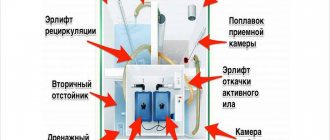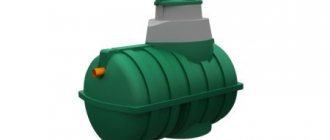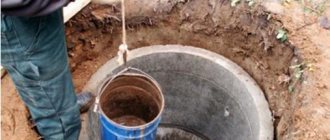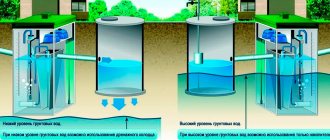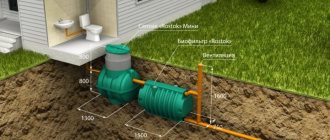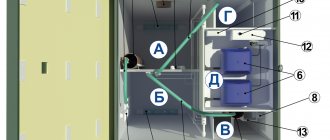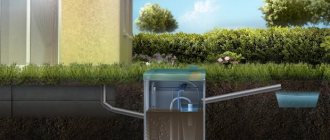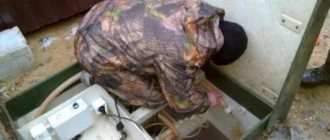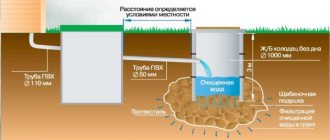Why is SES permission required for installing a septic tank?
The construction of a sewer system on any suburban area is a complex of complex works that involves not only laying pipes, but also installing a cesspool or a finished septic tank. To install a septic tank, permission from the SES is required. There is no way to do this without collecting a package of documents. Why is this required? The problem is that groundwater and the soil itself can be contaminated by runoff and chemical waste. Improper cleaning of a septic tank with chemicals can lead to various diseases and contamination of the residential area of the entire site. Therefore, before starting work, it is necessary to design a sewer system, collect a package of documents and submit an application to the SES.
Before constructing a sewer system, you need to make a project, then collect the necessary documents and submit an application to the SES.
Documentation package
A septic tank is an installation for the accumulation and treatment of household waste. Not only liquid but also solid waste, harmful gases, and microorganisms accumulate in sewer tanks. Such installations require constant monitoring by sanitary and epidemiological authorities. This makes it possible to protect groundwater from contamination, prevent the spread of various diseases, and prevent wastewater from entering the residential area. For the safety of both yourself and others, you must obtain appropriate permission to use a septic tank.
How to obtain permission from the SES and where, what package of documentation will need to be collected? Among the main documents that will be required by the SES, it is worth noting:
- availability of a technical passport;
- a detailed diagram of the septic tank installation, which the design organization will help you draw up;
- project for a residential building;
- package of documentation on ownership of the site and building;
- detailed topological survey of the entire site (obtained from the relevant organization);
- an agreement with various organizations on the removal of all liquid household waste.
Scheme of a multi-chamber septic tank.
After the documentation package has been collected, you can submit an application to the SES for the installation of a septic tank. This is done either by the sanitary epidemiological station of the region or by an environmental protection organization. It must be remembered that the application can only be submitted together with a package of documentation. You will have to wait about a month for permission from the SES. There is one more point in installing septic tanks for suburban areas. After installing a wastewater storage tank, SES has the right to conduct scheduled and unscheduled inspections. Employees have the right to check the quality of wastewater treatment and the contents of the septic tank.
Septic tank options for the site
First of all, they are:
- Monolithic
, when the sewer tank fully meets the waterproofing requirements and does not need to be additionally treated from the inside with bitumen or cement mortar. - Prefabricated
. Such systems will have to undergo a thorough waterproofing process, because there will be joints and gaps. Typically, this type of septic tank is not easy to install and requires a lot of time.
And this could be:
- Brick,
- Metal or plastic containers,
- Concrete or concrete rings
According to their operating principle, septic tanks can be divided into the following types:
- Storage (their function is only to collect wastewater).
- Treatment. They contain bioactivators that purify and filter incoming wastewater. This is convenient because the resulting water can be reused. For example, for watering crops.
- With soil filtration system. Such septic tanks also perform the function of treating wastewater and releasing the resulting water into the ground.
Depending on how deep your septic tank will be located, they are divided into:
Perhaps one more gradation can be distinguished:
- Volatile
septic tanks that require connecting their system to the electrical network. - Autonomous
, working without electricity. And this, in general, is convenient.
Location conditions
You can’t just install a septic tank or cesspool on your property, since any sewer system poses a certain danger. If permission for installation has been received from the SES, you can begin installing an external sewage system. There are certain standards that regulate the distance from various objects, the depth of holes and other conditions.
To obtain permission from epidemiological stations to place a septic tank, you will have to choose the right location for the tank.
Today, SNiP 30-02-97 and SanPiN 42-128-4690-88 have a whole list of requirements for the location of cesspools on the territory of a personal plot:
Diagram of a septic tank for a cesspool.
- storage pits must be located on the territory adjacent to a private house; it is not allowed to discharge wastewater beyond the boundaries of the site without the appropriate connection and permission;
- the cesspool for drainage should be located at a distance of 10 m from the water main and 20 m from the drinking well, so that clean drinking water does not become contaminated with household waste, chemicals and wastewater;
- the distance from the septic tank to a residential building and other structures should be approximately 10-12 m. A closer location can lead to flooding of the foundation in the spring and destruction of building structures;
- there should be a distance of 1 m from the septic tank to the fence;
- The depth of the cesspool should not be more than 3 m, otherwise its maintenance will be difficult. A thick layer of silt and solid sediment will constantly accumulate at the bottom.
Distance from septic tank to fence
One of the important questions is: what should be the distance from the septic tank to the fence? There is no clear answer. Formally, at least 1 m (some lawyers claim 2 m). This is where the “interesting” part begins. The indicated distance of 1 meter is a special case when there is nothing behind or in front of the fence. If there are any underground communications (gas, water supply) behind the fence facing “the street”, then the calculation is made from them, and not from the wall. If there are bushes or trees along the fence on your site, then they are taken as the starting point. If there are no plantings at home, but there are plantings along the neighbor’s fence, then again measurements are taken from them. The circumstances are even worse when there are two houses between them. Here, from the closest point of the house to the beginning of the septic tank there should be at least 8-12 meters. The same applies to everything else: well, borehole, outbuildings, etc. Therefore, in principle, measuring from the fence does not make sense. Therefore, without agreement with neighbors and permission from the relevant authorities who know the laws and the availability of communications, there is no need to even think about VOCs.
Device options
Today it is possible to install various designs of cesspools for storing and partially processing wastewater. It can be:
- ordinary cesspools;
- engineering systems for accumulation and partial processing and separation of wastewater mass.
Sump pit diagram.
The simplest option, which is provided by the relevant permitting services, is cesspools that do not have an equipped bottom. They are constructed if the daily volume of wastewater discharged from a residential building is no more than 1 m³. Sewage pits are installed below the drinking water level so that the water in the well is not contaminated by wastewater.
When installing a septic tank, various parameters must be taken into account:
- requirements for the location of the pit;
- taking into account the type and properties of the soil at the installation site.
Standards for the location of a septic tank and a well in one area:
- if the site has clay soil, the distance between the well and the septic tank should be 20 m;
- for loam - from 30 m;
- for sandy loam and sandy soil - from 50 m.
If the planned volume of waste per day is more than 1 m³, you will have to abandon the design without a bottom in favor of a concrete or brick pit, a PVC or metal septic tank.
Expert advice
For the external sewer system of a private house, sealed septic tanks are recommended, which are not only more convenient to use, but are also highly reliable. They are usually installed by specialized stations. SanPiNs for them are as follows:
Sewerage diagram for a country house.
- During installation, the bottom of the pit should be inclined towards the service hatch, which is necessary for subsequent maintenance;
- the installation location is selected in such a way that the septic tank is located about 10 m from the residential building, and 1 m from the fence of the site;
- a sealed cesspool requires periodic cleaning with a special sewage disposal machine.
It is worth paying attention to a number of tips given by experts:
- for the access of special equipment it is necessary to provide a spacious and convenient place, so there is no need to hide the septic tank in the far corner of the site;
- During operation of the tank, methane may form, so it is recommended to equip the tank with a special ventilation system. According to the requirements of the sanitary and epidemiological station, it will be necessary to provide a ventilation pipe with a diameter of 10 cm. The height of the pipe above ground level should be 60 cm.
Communications supply
Scheme of the location of the cesspool relative to other objects.
A sanitary permit will have to be obtained not only for the installation of septic tanks, but also for all utilities that are located nearby. There are certain standards for the placement of pipes on the site:
- reinforced concrete and asbestos-cement pipes must be located at a distance of 5 m or more from the septic tank;
- cast iron pipelines with a diameter of up to 200 mm must be located at a distance of 1.5 m from the wastewater sump;
- cast iron pipelines with a diameter of 200 mm or more can be located at a distance of at least 3 m from the septic tank;
- gas pipes can be located at a distance of 5 m from the location of the septic tanks.
When installing a septic tank on a personal plot, you must remember to comply with all sanitary standards and obtain the appropriate permit. Sanitary standards regulate the location of the septic tank and establish minimum distances for laying other communications on the site. Taking into account the SES and installation of the septic tank relative to the location of the residential building and other buildings. It is worth being prepared for periodic inspections by employees of the sanitary and epidemiological station. But you should not be categorical about this, since all this is done for the safety of you and others.
Independent sewerage for apartment buildings.
One of the main tasks facing developers constructing high-rise residential buildings is connecting all utilities, ensuring the supply of electricity, hot and cold water, heating, and connecting other systems to the house, allowing potential residents to enjoy all the benefits of civilization.
In addition, sewerage problems in new apartment buildings in the Moscow region should be resolved as efficiently as possible. It’s good if their construction is carried out in an area with already developed infrastructure - then you can simply connect the residential complex to a centralized network. But what if it is completely absent or simply cannot cope with a significantly increasing load?
Where to place a septic tank on the site, taking into account standards and distances
Today, installing a sewer system on your own property is not a difficult task. You can build the structure yourself, or seek help from specialized companies. In any case, there is always a choice. Conventional cesspools have long become relics of the past. They have been replaced by high-quality, solid systems that rarely even require calling a sewer truck to pump out the contents.
And there are systems that work autonomously and without pumping. It all depends on your financial capabilities. Therefore, no matter what septic tank you choose for your country house, the main question is where to place the septic tank on the site
And here it is important to understand that strict rules and regulations have been developed here, the task of the site owner is to adhere to them.
Requirements for autonomous sewerage for apartment buildings
The only way out of this situation is an autonomous sewer system for apartment buildings. But the options with cesspools and other similar structures are absolutely not suitable in this case, since the construction company will have to undertake not only their implementation, but also very expensive maintenance, removal and disposal of wastewater using special equipment, the rental of which is expensive .
There remains the option of purchasing and installing a modern septic tank, but even in this case, a number of nuances must be taken into account. For example, sewerage for apartment buildings must meet the following requirements:
- processing of large volumes of water, as well as resistance to large volley discharges or uneven flow of wastewater into the system;
- high quality cleaning. Very often it is necessary to discharge purified water into reservoirs located near residential complexes, so all measures should be taken to minimize environmental pollution;
- simple maintenance. It can be carried out both by construction organizations installing sewerage systems in apartment buildings, and by utility services or service companies. Payment for this service is included in the rent, so a minimal amount of work will help keep it to a minimum.
All these requirements are fully met by the autonomous sewage system of apartment buildings Unilos MEGA, the purchase of which we offer to construction companies. It has a simple modular design and can be installed in separate units with subsequent expansion of the system. This station differs from analogues offered on the modern market by its increased operating efficiency, as it can effectively perform the following functions:
- mechanical wastewater treatment, filtration of contaminants that do not dissolve in water;
- high-quality biological treatment using activated sludge, which destroys organic matter and nitrogen compounds;
- post-treatment of wastewater in a special unit located in a separate room;
- disinfection of clarified water before its discharge into a reservoir.
As a result, the wastewater is purified to such an extent that it can even be discharged into drinking water bodies. In addition, the advantages of the independent sewage system Unilos MEGA include:
- ease of installation, the ability to carry out all work on sewerage installation in apartment buildings independently or with the involvement of specialists from our company;
- economical energy consumption;
- a large selection of MEGA septic tanks, designed to work with different numbers of consumers and different volumes of wastewater;
- the possibility of long-term use of private sewerage for an apartment building with minimal maintenance.
All this will allow the developer of a modern residential complex to install and put into operation an effective sewer network within a few weeks, which will successfully cope with the treatment of large volumes of wastewater.
How it works
Let's understand the general principles of wastewater treatment in a septic tank.
What happens to the wastewater?
- From the house, they flow by gravity into the primary settling tank - a chamber where, under the influence of the difference in density, mechanical separation is carried out. Heavy fractions settle to the bottom, light fractions float to the surface and form a crust on the surface. The vital activity of anaerobic bacteria contributes to the processing of organic compounds into volatile hydrocarbons (primarily methane) and water.
- The specially shaped overflow removes settled water just below the surface level. Neither heavy fractions nor crust fall outside the first chamber.
- The overflowed wastewater ends up in soil filtration. How can it be done? The most compact solution is a filter well. In essence, it is just a pit with perforated walls and a dirt bottom. The drainage layer at the bottom and outside the walls allows you to increase the absorbent surface area to the maximum; in addition, it significantly slows down siltation (yes, it is still possible, albeit over a much longer period).
The space behind the walls of the well is filled with drainage - brickwork.
- Where soils have low absorption capacity, a filtration field is used. In an area free of buildings, several ditches or a pit of small depth but a significant area are dug. Drainage (perforated) pipes or infiltrators are laid on a backfill of crushed stone with a thickness of 10 centimeters or more - special simple devices for compensating for volley discharges, externally resembling inverted troughs. They are covered with crushed stone on top and covered with soil.
- Finally, in the case where the soil practically does not absorb water, a slightly modified version of the filtration field is constructed. Drainage pipes are laid on two levels with a height difference of 30-70 centimeters. They are backfilled with sand. The wastewater is supplied through the upper level pipes; Through the lower drainage pipe system, filtered water is discharged into a ditch or a nearby body of water.
Additions and improvements
One of the main problems of the described septic tank operation scheme is the relatively low degree of wastewater treatment.
Are there ways to improve it?
- There may be several settling chambers. In fact, the more there are, the cleaner the water comes out.
Multi-chamber septic tanks provide the best quality of wastewater treatment.
However: the price of better cleaning is the need to remove sludge from the appropriate number of chambers.
- Aeration of one or more chambers is a method of increasing the degree of purification, used in factory-produced deep biological treatment stations. This is exactly how a typical septic tank for an apartment building works: disposing of partially treated wastewater with a daily volume of several tens of cubic meters without harming the environment is, to put it mildly, problematic. How does aeration improve cleaning?
- When wastewater is saturated with oxygen, aerobic bacteria are sharply activated. They are much more voracious compared to anaerobic ones and are able to absorb larger amounts of organic matter in the same time. To provide them with maximum contact with contaminants and air, filling with a developed surface is usually used in the aeration chamber - brushes, complex-shaped plastic floats, etc.
- Oxygen at the same time sharply accelerates the oxidation processes of surfactants included in detergents and products of partial processing of organic compounds by bacteria.
- The settling tanks of non-volatile (without forced aeration) septic tanks are often forcibly seeded with bacterial cultures that are more aggressive than those arising naturally. As a rule, after a single loading dose of a bacterial preparation, maintenance portions are added at intervals of 1 to 3 months.
Bacterial preparation for local sewerage.
Thanks to all the measures described, not only a higher (up to 98 percent) degree of wastewater treatment is achieved, but also a significant reduction in the amount of sludge.
How to maintain Unilos MEGA
As we have already mentioned, maintenance of autonomous sewerage systems in apartment buildings can be performed by a service company or a housing office. You can also contact us - experienced specialists will always come to the rescue, ensure timely and high-quality work on eliminating excess activated sludge, which gradually accumulates during the operation of the station, diagnosing compressor and pumping equipment, repairing or replacing airlift elements.
Professional maintenance of a sewerage cleaning system for an apartment building makes it possible not only to ensure its flawless operation, but also to avoid unpleasant emergency situations due to a decrease in equipment capacity, pump or compressor breakdown.
Examples of water purification systems in a residential building and housing and communal services
Our collection contains many examples of installing water purification systems for apartment buildings, cottage communities and public institutions, some of which are:
- Water treatment system for two villages in the Novgorod region
- Iron removal station for a cottage village in the Moscow region
- Comprehensive cleaning system in a shopping and entertainment center in New Riga
You can see these and other examples of filters for water purification in residential buildings in our gallery. If you are interested in our objects and you want to know about them in more detail, contact us by phone 8-499-391-39-59 or email and our specialists will answer all your questions.
Services for the installation of autonomous sewerage systems in apartment buildings
In addition to high-quality maintenance of autonomous sewage systems of apartment buildings, our company provides the following services:
- selection of Unilos MEGA wastewater treatment complexes for a specific facility, performance of all necessary calculations and studies, development of projects and schemes for autonomous sewerage of apartment buildings;
- installation of the station, including excavation work, construction of prefabricated buildings for post-treatment and disinfection units, installation and connection of Unilos MEGA and commissioning of equipment;
- if necessary, carry out repair work, replace individual elements of the station, as well as its expansion and installation of new units to improve the quality of wastewater treatment.
Sanitary standards for pits and septic tanks.
The problem of draining domestic wastewater in a private house or on a summer cottage is solved in most cases by installing a cesspool or septic tank. Due to the fact that wastewater can have a significant impact on the environment and the health of the population, primarily the homeowner’s family, all aspects of the creation and placement of these structures are strictly regulated by legislation.
The problem of draining domestic wastewater in a private house or on a summer cottage is solved in most cases by installing a cesspool or septic tank. Due to the fact that wastewater can have a significant impact on the environment and the health of the population, primarily the homeowner’s family, all aspects of the creation and placement of these structures are strictly regulated by legislation.
All activities related to this issue are regulated by the Federal Law “On the Sanitary and Epidemiological Welfare of the Population” N 52-FZ,
which was adopted on March 30, 1999.
This law primarily protects the health of the homeowner. He has a personal interest in complying with the provisions of the law, since if the rules and regulations contained therein are violated, the health of his family members and his own life will be at risk. From a legal point of view, strict compliance with the law is the responsibility of citizens of the Russian Federation, and its violation entails liability provided for by law.
Obtaining permission to develop
Uncontrolled placement of septic tanks and cesspools on the territory of a household or outside its boundaries poses a possible threat to the environment. The law prohibits the construction of these facilities without design documentation, which is submitted to the sanitary and epidemiological service for approval, so that the owner of the site receives permission to carry out work and is able to equip a treatment facility on his territory.
Sanitary and epidemiological conclusion
A building permit can be obtained only if the construction and sanitary standards in force at the time of consideration of the documents are fully complied with.
An important point that is emphasized when reviewing the documentation is the correct choice of location where the treatment facility will be located.
Obtaining a permit does not mean that the owner of the site has the opportunity to arbitrarily make changes to the project, since regulatory authorities have the right to subsequently check the compliance of the structure with the presented documentation.
Regulatory acts defining the procedure for arranging treatment facilities
When constructing a cesspool or installing a septic tank, in addition to Law No. 52?FZ, it is necessary to comply with the provisions of other regulations. These include some sanitary rules and regulations (SanPiN) and construction norms and regulations (SNiP):
- SNiP 2.04.03-85, which are the main document regulating the construction of external sewerage.
- SNiP 2.04.04-84, as well as SNiP 2.04.01-85, regulating the construction of external and internal water supply systems in cases where water supply occurs through boreholes and wells.
- SanPiN 2.1.5.980-90, containing requirements for the organization of security measures designed to preserve the cleanliness of surface water bodies.
- SanPiN 2.2.1/2.1.1.1200-03, which contain requirements for the organization of sanitary zones around objects that pose an environmental hazard.
Distance between the septic tank and the water intake point
An important condition when placing a treatment plant on a site is to maintain a minimum distance from the designed object to the well or well.
Distances between the septic tank and the house
This requirement is explained by concern for the well-being of the population, since this measure prevents untreated wastewater from entering underground aquifers. Failure to comply with this norm can cause various diseases. Compliance with the requirement is also important when installing a septic tank, since, despite its tightness, emergency situations cannot be ruled out due to a burst pipe or depressurization of a connection.
For this reason, the distance from the septic tank or cesspool to the water intake point should be as wide as possible. The above documents determine that the distance of the site for the treatment plant from the point of water intake depends on the presence and quality of filter soil between the soil layer, where the final filtration of wastewater will occur, and the aquifer.
Determination of the filtering qualities of soil on a site is carried out through a hydrogeological study, which will allow one to assess the composition of the soil within the boundaries of the site. If the connection between these soil layers is not detected, then the distance between the water intake site and the cesspool cannot be less than 20 meters.
The higher the filtering capacity of the soil, the greater the minimum distance to the water intake point becomes. Sandy soil, as well as sandy and loamy soils, have the best filtering qualities. If there are soils of this type on the land plot, the distance separating the water intake and treatment plant should be from 50 to 80 meters.
When installing a septic tank or cesspool, regulations regarding distance from water pipes must also be observed. The distance to the pipes that supply drinking water to the house must be at least 10 meters. This requirement is put forward to protect the consumer in the event that a water pipe becomes depressurized so that wastewater cannot penetrate into it. In addition to the distance to the water intake point, the slope of the terrain must also be taken into account. The location for the treatment plant equipment must be below the water intake point.
Location of the septic tank on the site
When planning a place to install a cleaning device, you need to adhere to the rules; this is the only way to be sure that there will be no problems in the future. After all, even having received permission from the relevant authorities, you cannot do as you want, it is possible that in the future the work performed will be checked for compliance with the project.
Video: Sanitary standards for the installation of wells and septic tanks
Regulations
When installing a septic tank, you will have to adhere to the rules and regulations that are regulated by the following documents:
- The fundamental document that you need to focus on first is that it regulates the process of constructing an external sewerage network and structures;
- If a well or a well is used as a water supply, the requirements specified in - external networks and water supply and sewerage structures and - internal water supply and sewerage systems of buildings are additionally taken into account;
- – the requirements for protective measures aimed at maintaining the purity of surface waters are described;
- – regulates standards for the creation of sanitary protection zones near environmentally hazardous objects.
Distance to well
The most stringent requirements are prescribed for placing a septic tank near water intake points. It is no secret that the release of sewage into groundwater can lead to contamination of a large number of sources and cause poisoning in people.
And even taking into account the fact that today most factory installations are sealed and made from heavy-duty materials, no one is immune from an accident. That is why the distance from the septic tank to the source of drinking water (well, borehole, etc.) should be as large as possible.
A properly located septic tank should be located at a distance of 20 meters or more from the well or borehole. In addition, the water intake point must be located above it in the direction of groundwater flow. However, if the type of soil predominant on the site is sandy, sandy loam or loamy, then the minimum permissible distance increases to 50 meters.
Distance to water supply
Regulatory documents also spell out rules for locating a septic tank near centralized water supply pipes. It says that the septic tank should be no closer than 10 meters from the water supply. This will protect the water supply from contamination in the event of an accident.
Distance to home
According to the rules, the distance from the house to the treatment plant must be at least 5 meters. This requirement must first of all be observed for wastewater treatment systems (infiltrators, drainage ditches, filtration fields, etc.). Local treatment plants, such as, for example, can be installed closer.
It is also not advisable to locate settling tanks more than 5 meters apart, since the longer the pipeline, the higher the risk of its depressurization. Therefore, installing septic tanks more than 20 m from the foundation of the house is not recommended.
Distance to neighboring plot, fence
Of course, you want to place the septic tank to the side and away from your home, but you should not ignore the interests of your neighbors. Therefore, when drawing up a project, the following rules should be taken into account:
- from the fence of the neighboring plot to the septic tank there must be at least 2 m;
- to a busy road – 5 meters.
Distance to the garden
Plants can die from too much moisture. If there is a treatment plant next to the garden, then trees and shrubs may get sick and die from excess moisture. Therefore, the location of the septic tank, and especially soil wastewater treatment systems, is not advisable closer than 5 meters from trees.
Other requirements
When choosing a place to install a septic tank, you should take into account factors such as:
- installation is recommended to be done in places with soft soil, this greatly facilitates excavation work;
- from the foundation of outbuildings to the septic tank must be at least 3 m;
- SNiP also regulates the regular cleaning of settling chambers, so treatment facilities must have free access for a sewage truck.
Distance between treatment plant and residential building
Regulatory documents also establish requirements for the location of a wastewater treatment plant in relation to a residential building. In particular, the documents provide the following:
The cesspool or septic tank is located at a distance of more than five meters from the foundation of the building. This requirement is made for reasons of sanitary safety. You should also take into account the fact that the treatment plant is a source of unpleasant odors.
However, increasing the distance should not interfere with the operation of the treatment system, since the operation of long sewer pipes can be difficult and will require the creation of a large number of inspection wells.
Other requirements regarding the choice of location of the treatment plant
When determining a place for a septic tank or cesspool, it is also important to take into account other requirements of regulatory documents:
The treatment facility must be located at a distance of at least one meter from the foundation of any outbuilding. This will avoid erosion of the foundations of buildings located in the neighborhood if the tightness of the treatment system is compromised.
To periodically clean a cesspool or septic tank from solid residues, it is necessary to provide for the possibility of access to the site by a sludge sucker.
Special requirements regarding the arrangement of cesspools
According to SanPiN 42-128-4690-88, it is allowed to build garbage pits on land plots that do not have a sewer system. The walls and bottom of these pits must be impenetrable. In addition to the underground part, these treatment facilities must have an above-ground part, which consists of a grate and a cover. Domestic wastewater is collected in the cavity of the structure, and solid waste and debris are retained on the grate. Debris from the grate is collected in a waste drawer. The cesspool is cleared of liquid waste at least twice a year.
Cesspools are subject to periodic disinfection; for this purpose, a mixture is used, including:
- Sodium methixalate (10%),
- Creolin (5%),
- Bleach (10%),
- Sodium hypochlorite (5%),
- Naphthalizol (10%).
The use of dry bleach for disinfection is strictly prohibited.
After deciding to install a wastewater treatment plant on a site, the owner of the territory must carefully study the rules and regulations governing this issue to ensure their strict compliance and avoid conflicts with regulatory agencies and neighbors.
Only by fulfilling the requirements contained in the regulatory documents will it be possible to approve the project with the sanitary and epidemiological service, and also be confident in the trouble-free operation of the cesspool or septic tank.
Cesspools and storage septic tanks
In private houses, in addition to septic tanks, you can build simple cesspools without a bottom. However, there are certain requirements that apply directly to them:
- They must be waterproof.
- There must be a cover or grill over the structure.
- The pit must be cleaned at least twice a year.
- In addition, regular disinfection is required with a mixture containing a number of cleaning elements. Dry bleach cannot be used in this case.
A few decades ago, this type of sewer structure was called a cesspool. seemed the only possible one. Today it is almost never used, but you can still find it in some places. The structure is a pit with no bottom. The material can be brick, cement, concrete rings or another type. The liquid from the drain, entering the pit, freely seeps into the soil, at the same time being purified. All solid organic matter settles, accumulates and is then purified. Previously, holes were simply dug, without caring about their waterproofness, and as they accumulated, they were left and a new one was dug.
Today, an alternative to a cesspool is a storage septic tank. It differs in that the wastewater does not pass into the soil, but remains completely in the container.
Connecting sewer pipes to an installed Topas septic tank
Such a structure, installed according to the above rules, is possible, but it will only be advisable if the owners of the house rarely live in the house. If you stay permanently, you usually choose other options.
Cleaning septic tanks
This type of device is the most common. It consists of two or three chambers where the liquid is purified and then released into the soil for further purification. A septic tank can clean up to sixty percent. Therefore, such water cannot be used for technical needs, much less for drinking.
Recommended reading: Review of types of septic tanks
Typically, water flows out to areas specially designated for this purpose: filtration fields. They can be arranged in any type of soil. But sandy and sandy loam types are most suitable for them. In other cases, significant additional expenses will be required. Therefore, they are mostly abandoned in favor of another type of septic tank.
If you buy ready-made devices produced at a factory, they are completely sealed and very durable structures. And if the installation is carried out correctly, it will protect the environment and will not harm human health. But, of course, you cannot ignore the safety rules; they should be followed in any case.
Local treatment stations
Local cleaning stations are the most modern devices that provide the best cleaning, which reaches a percentage of up to ninety-eight. They provide various cleaning methods. This is also a sump where solid waste settles at the bottom and light waste floats to the surface. It is also a biological natural purification using special microorganisms: aerobic and anaerobic bacteria, which decompose waste and carry out further work.
Almost all VOCs are energy dependent, and for their operation an uninterrupted supply of electricity must be ensured. Often autonomous stations are installed for this purpose. Naturally, such designs are the most expensive. And they will only be needed if people live in the house permanently. In other cases, it is better to use other types of septic tanks.
VOC is by far the most reliable option for both cleaning and the functioning of the system as a whole. But even in this case, it is necessary to adhere to the current norms and rules and install the structure only with permits from regulatory authorities.
If you do not comply with this norm, then SES workers have the right to fine the violator and even demand dismantling of the structure.
https://youtube.com/watch?v=SorAAKhicso
Thus, having decided to build a septic tank on your site, you need to carefully study the available documents. Only then can you be sure that the project will be approved by the SES, the system will work perfectly, and conflicts with neighbors on this issue will be excluded.
